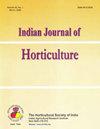Genetics of downy mildew resistance in indigenous cucumber germplasm
Q4 Agricultural and Biological Sciences
引用次数: 0
Abstract
Cucumber (Cucumis sativus L.) is a major Cucurbitaceous vegetable crop widely grown in tropical andsubtropical regions of the world. Downy mildew is the most damaging disease in cucumber worldwide causingsignificant yield loss. The wide diversity in terms of different economically important traits including severityto downy mildew infestation is available in Indian-originated germplasm. To investigate the genetic inheritanceof cucumber downy mildew disease resistance, one resistant genotype (DC-70) from India was crossed with acontrasting susceptible genotype (DC-773). The parents and their progenies were evaluated in both field andnet house conditions for downy mildew disease resistance. Field condition data were recorded 4-times from30 days until the plants die. The lower leaf surface was inoculated 20-25 days after sowing at the seedlingstage by spraying the inoculum. The proportion of infection was recorded 4-times from 8-days to 65-daysafter inoculation, and the per cent disease index and area under the disease progress curve (AUDPC) werecalculated from these proportions. Based on the PDI and AUDPC, it was established that resistance to downymildew in the genotype, DC-70 was controlled by a major gene. Additive-dominance model fits the segregationdata and the additive effect was significant. Finally, the downy mildew disease inheritance pattern indicatedthat it is controlled by a single recessive gene in DC-70, which can be successfully introgressed into desiredelite genotypes to facilitate the downy mildew resistance breeding programme.乡土黄瓜种质抗霜霉病的遗传研究
黄瓜(Cucumis sativus L.)是一种主要的葫芦科蔬菜作物,广泛生长在世界热带和亚热带地区。霜霉病是世界上危害最大的黄瓜病害,造成黄瓜产量的重大损失。在不同的经济重要性状方面,包括霜霉病的严重程度,印度源种质具有广泛的多样性。为研究黄瓜霜霉病抗性的遗传特性,将一种来自印度的抗性基因型DC-70与对照感病基因型DC-773进行杂交。在田间和网房条件下对亲本及其后代进行了霜霉病抗性评价。30 d至植株死亡,共记录4次田间条件数据。苗期播种后20 ~ 25 d,采用喷施接种剂的方法接种下叶表面。接种后8 ~ 65 d,记录4次感染比例,计算疾病百分率和疾病进展曲线下面积(AUDPC)。基于PDI和AUDPC,确定了DC-70基因型对霜霉病的抗性由一个主基因控制。加性优势模型与分离数据吻合,加性效应显著。最后,霜霉病遗传模式表明,DC-70受单隐性基因控制,该基因可以成功渗入到所需的基因型中,以促进抗霜霉病育种计划。
本文章由计算机程序翻译,如有差异,请以英文原文为准。
求助全文
约1分钟内获得全文
求助全文
来源期刊

Indian Journal of Horticulture
农林科学-园艺
CiteScore
0.50
自引率
0.00%
发文量
22
审稿时长
4-8 weeks
期刊介绍:
Information not localized
 求助内容:
求助内容: 应助结果提醒方式:
应助结果提醒方式:


